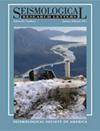Subdaily Ambient Noise Monitoring at Parkfield, California, by Combining C1 and C3
IF 3.2
3区 地球科学
Q2 GEOCHEMISTRY & GEOPHYSICS
引用次数: 0
Abstract
Abstract Monitoring the temporal variation in seismic velocity plays a critical role in understanding the dynamic processes of the subsurface at different scales. Many seismic velocity changes related to earthquakes and volcanic activities have been obtained using ambient noise correlation in recent years; however, their temporal resolution is limited, typically from a few to dozens of days, which makes it challenging to explore the valuable but short-duration changes in subsurface media. In this article, we develop a method based on the correlation of the coda of the ambient noise correlation (C3) with a multiple-component combination and introduced singular value decomposition-based Wiener filter denoising technique. Using permanent network data, we achieved subdaily ambient noise monitoring at Parkfield, California, using 4-hr cross-correlation stacking with 2-hr step. We identified that the maximum seismic velocity drop delayed the mainshock of the 2004 Mw 6.0 Parkfield earthquake by ∼41 hr, during which the temporal velocity process may have been affected by strong aftershocks, including an Mw 5.0 aftershock that occurred one day after the mainshock; however, no significant precursory change was detected. Our method provides an opportunity for monitoring the short-term change of underground structures based on the widely distributed seismic networks. In addition, the idea of obtaining reliable subsurface information within a short time through high-order noise correlation in this work has important enlightenment for ambient noise imaging and monitoring in broader fields.结合C1和C3的加州帕克菲尔德地区亚日环境噪声监测
摘要监测地震速度的时间变化是了解不同尺度下地下动态过程的关键。近年来,利用环境噪声相关技术获得了许多与地震和火山活动有关的地震速度变化;然而,它们的时间分辨率有限,通常只有几到几十天,这使得探索地下介质中有价值但持续时间短的变化具有挑战性。本文提出了一种基于多分量组合的环境噪声相关(C3)尾值相关性的方法,并引入了基于奇异值分解的维纳滤波去噪技术。利用永久网络数据,我们利用4小时的交叉相关叠加和2小时的步进,在加州帕克菲尔德实现了亚日常环境噪声监测。我们发现,最大地震速度下降将2004年6.0 Mw Parkfield地震的主震推迟了约41小时,在此期间,时间速度过程可能受到强烈余震的影响,包括主震后一天发生的5.0 Mw余震;然而,没有发现明显的前兆变化。我们的方法为基于广泛分布的地震台网监测地下结构的短期变化提供了机会。此外,本文提出的通过高阶噪声相关在短时间内获得可靠的地下信息的思路,对更广泛领域的环境噪声成像和监测具有重要的启示。
本文章由计算机程序翻译,如有差异,请以英文原文为准。
求助全文
约1分钟内获得全文
求助全文
来源期刊

Seismological Research Letters
地学-地球化学与地球物理
CiteScore
6.60
自引率
12.10%
发文量
239
审稿时长
3 months
期刊介绍:
Information not localized
 求助内容:
求助内容: 应助结果提醒方式:
应助结果提醒方式:


